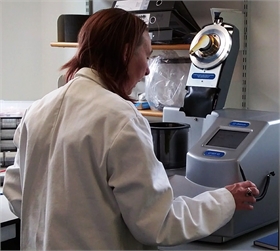Dr Elisabeth (Beth) Steer is Specimen Preparation Technician at the Nanoscale and Microscale Research Centre, (NMRC), in the Faculty of Science at the University of Nottingham. The Centre is a cross-faculty hub providing facilities and expertise for research across the engineering, physical and life sciences. The Centre is well placed and ready to support academics in achieving excellence in their research and leveraging the funding available in nanoscience and related interdisciplinary areas. It is proud host to a unique suite of over twenty instruments which facilitate the imaging and analytical investigation of materials from a wide range of scientific disciplines. The NMRC also welcomes commercial and industrial access making it one of the most versatile imaging centres in the country.
Beth’s work covers many different preparation processes. These include sputter coating, evaporation coating, critical point drying, resin embedding, microtomy & ultramicrotomy, polishing and grinding. The key to successful coating performance is reproducibility. Beth takes up the story: “We use the Quorum 150T S turbomolecular-pumped system to sputter coat samples with iridium here prior to analysis on a JEOL 7100 FEG-SEM. The iridium coating is essential as the other types of coating we have here (Pt, Au) have a grain size too large for use with the FEG as the structure of the coat covers nano features we’re trying to observe. When working on a nanoscale, it’s very important to have an even coat covering the samples that is reproducible. We tend to coat between 5-15 nm.”
Continuing, she says “Compared to our other coaters, the Q150T has a very controllable, easily reproducible coat – helped by the turbo pump. The reproducibility is very important to us as if we coat a sample with something that varies by a few nm then the sample is difficult to interpret and once we find a thickness that works for a sample type we need to be able to reproduce it to 1 nm. Film thickness is very important for us. It varies with every sample type, but we find the ability to produce coats <5 nm essential for FEG work and that isn’t really possible without a Film Thickness Monitor.”
Sales Manager, Dennis Fitzpatrick, says “Quorum offers the most versatile range of sputter and carbon coaters for electron microscopy today. The Q150T is available in three formats: sputtering, carbon evaporation or both. Depending upon the selected configuration, the Q150T can be a top-of-the-range sputter coater for high resolution scanning electron microscopy (SEM), a carbon coater suitable for SEM and transmission electron microscopy (TEM), or both – in a single easy-to-use system. Other options include metal evaporation and aperture cleaning.”



